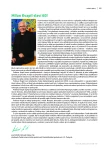Estimating the prevalence of potential drug interactions in patients treated with 5 and more drugs in the Czech Republic and Slovac Repuplic
Authors:
Richard Češka 1; Ivan Tkáč 2
Authors‘ workplace:
Centrum preventivní kardiologie III. interní kliniky 1. LF UK a VFN v Praze
1; IV. interná klinika LF UPJŠ a UN L. Pasteura, Košice, Slovenská republika
2
Published in:
Vnitř Lék 2016; 62(7-8): 514-520
Category:
Original Contributions
Overview
Polypragmasy is currently a growing phenomenon, leading to an increased risk of drug interactions. Empirical data to document this trend can only be obtained through a field survey, which, however, is missing in both Czechia and Slovakia. Therefore an international, multicentre, observational, non-interventional study “Estimating the prevalence of potential drug interactions in patients treated with 5 and more drugs in the Czech Republic and Slovakia” was conducted, with the primary aim to identify the prevalence of potential drug-drug interactions in the conditions of routine clinical practice. The patients aged 18 years or more and treated with 5 and more drugs simultaneously were recruited from 21 September 2013 onward in 4 consecutive quarters, each patient maximally once in a single quarter. The participating sites consisted of general practitioners and outpatient specialist clinics (1 040 physicians altogether), chosen to match the structure of medical specialties as well as to cover the entire territory of the respective country. The data was evaluated with descriptive statistical methods. The level of health risk associated with drug-drug interactions has been expressed by an Interaction Index, a measure developed to estimate the probability of critical risk of drug-drug interaction The prevalence of prescriptions with Interaction index ≥ 12, i.e. exposing patients to adverse effects, was significantly influenced mainly by the amount of drugs prescribed and their profile in relation to the risk of interactions; on the other hand, age or gender did not play an important role. The identified seasonal variations in the prevalence of interactions can be explained by additional medication associated with seasonal illnesses.
Key words:
drug interactions – interaction index – polypharmacy
Sources
1. Květina J, Grundmann M. Farmakologické interakce. Klin Farmakol Farm 2003; 17(1): 17–21.
2. Mičuda S, Martínková J, Chládek J et al. Význam polymorfismu metabolismu léčiv v moderní farmakoterapii. Remedia 1998; 8(4): 226–236.
3. Suchopár J, Prokeš M. Polypragmazie a lékové interakce. Vnitř Lék 2011; 57(9): 755–759.
4. Databáze lékových interakcí Infopharm. Dostupné z WWW: <http://www.drugagency.cz/infromace-o-lecich.php?id=18>.
5. Prokeš M, Vitásek Z, Suchopár J et al. Výskyt lékových interakcí u klientů Zaměstnanecké pojišťovny Škoda. Prakt Lék 2005; 85(8): 457–460.
6. Pirmohamed M, James S, Meakin S et al. Adverse drug reactions as cause of admission to hospital: prospective analysis of 18 820 patients. BMJ 2004; 329(7456): 15–19.
7. Práznovcová L. Farmakoterapie seniorů v České republice v kontextu k farmakoekonomice. Česká geriatrická revue 2003; 1(4): 25–31.
Labels
Diabetology Endocrinology Internal medicineArticle was published in
Internal Medicine

2016 Issue 7-8
Most read in this issue
- Treatment of liver cirrhosis – actually possibility of ambulant internist
- Sepsis – how to recognize and what to focus on – back to basics in the light of the new definition
- The skin – a mirror of internal diseases
- Prevention and therapy of sarcopenia in the ageing
